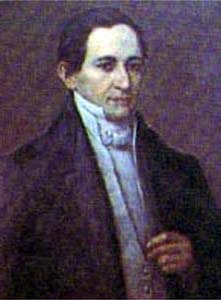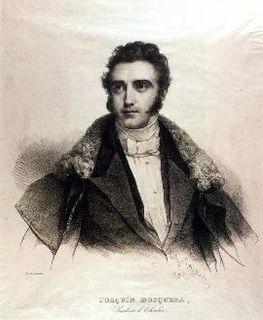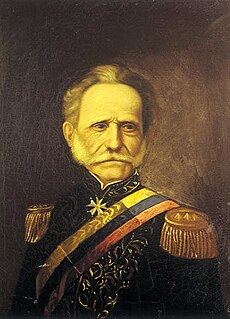 W
WSimón José Antonio de la Santísima Trinidad Bolívar y Palacios Ponte-Andrade y Blanco, generally known as Simón Bolívar and also colloquially as El Libertador, or the Liberator, was a Venezuelan military and political leader who led what are currently the countries of Venezuela, Bolivia, Colombia, Ecuador, Peru, and Panama to independence from the Spanish Empire.
 W
WMiguel Ángel Builes Gómez was a Colombian Roman Catholic prelate who served as the Bishop of Santa Rosa de Osos from 1924 until his death. He was the founder of the Xaverian Missionaries of Yarumal (1927) and the Missionaries of Saint Thérèse (1929) as well as the Contemplative Sisters of the Blessed Sacrament (1939) and the Daughters of Our Lady of Mercy (1951). Builes was a prolific writer of pastoral letters and he condemned a vast range of issues in Colombian life that he deemed to be either too liberal or in breach of traditional doctrine; among those he condemned were women wearing trousers and various dance forms. He was a staunch defender of the faith which made him a controversial figure in his diocese with those praising and condemning him for his activism; but there were those who praised his orthodox views and his defense of doctrine in the face of a wave of secularism.
 W
WDomingo de Caycedo y Sanz de Santamaría was a Colombian statesman who served as the vice president of Gran Colombia and the Republic of New Granada. He served as President of Colombia a total of eleven times, the most terms any president has served to date. He is also credited for creating the Republic of New Granada after the division of Venezuela and Ecuador.
 W
WLaureano Eleuterio Gómez Castro was a Colombian politician and civil engineer who served as the 18th President of Colombia from 1950 to 1953. In November 1951 poor health led him to cede presidential power to Roberto Urdaneta Arbelaez. On 13 June 1953, when he tried to resume his presidency, he was overthrown in a military coup led by Gustavo Rojas Pinilla. During the three decades prior to being elected president, Gómez was a radical leader of the Conservative Party and is widely considered to be one of the most brilliant and potent orators of the Congress of Colombia. However, he remains a controversial figure because of his sympathy for authoritarian regimes and the dictatorial nature of his government.
 W
WSpanish viceroys of the colonial Viceroyalty of New Granada (1717−1819) located in northern South America.
 W
WJosé Hilario López Valdés was a Colombian politician and military officer. He was the President of Colombia between 1849 and 1853.
 W
WFrancisco Mariño y Soler was a military, political, and aristocrat. He was a patriot, Knight of the Order of Santiago.
 W
WJosé Ignacio de Márquez Barreto was a Colombian statesman, lawyer and professor, who first served as Vice President of the Republic of the New Granada after being sworn in by congress in 1832, and under the presidency of Francisco de Paula Santander, and subsequently was elected President of the Republic of the New Granada for the presidential term of 1837 to 1841.
 W
WAna María Martínez de Nisser was a Colombian heroine and writer. She participated in the Battle of Salamina on 5 May 1841 during the War of the Supremes. She later published a book about the events of 1840–41.
 W
WJoaquín Mariano de Mosquera-Figueroa y Arboleda-Salazar was a Colombian statesman and a Founding Father of Colombia who served as the 3rd and 5th President of Gran Colombia. Mosquera also served as Vice President of the Republic of New Granada. During the administration of President Simón Bolívar, he was named as the 1st Envoy Extraordinary and Minister Plenipotentiary to the nascent states of Peru, the United Provinces of South America, and Chile with the purpose of creating unity amongst the South American nations.
 W
WTomás Cipriano Ignacio María de Mosquera-Figueroa y Arboleda-Salazar was a Colombian general, political figure, and enslaver. He was president of Colombia four times. The first time was as president of Republic of New Granada from 1845 to 1849. During the Colombian Civil War of 1860–1862 he led liberal forces in a civil war against conservative factions. After the liberals won, a new, federalist constitution was implemented, which established a two-year presidency, and the nation renamed the United States of Colombia. Mosquera served twice as president of the new government. From 1861 to 1862 he served in a non-elected, interim manner, while the constitution was written. From 1862 to 1864 he served in an elected manner. He had a fourth term from 1866 to 1867. Due to the liberal reforms carried out under his leadership, he is considered one of the most important persons in Colombian history of the 19th century.
 W
WJosé Celestino Bruno Mutis y Bosio was a Spanish priest, botanist and mathematician. He was a significant figure in the Spanish American Enlightenment, whom Alexander von Humboldt met with on his expedition to Spanish America. He is one of the most important authors of the Spanish Universalist School of the 18th century, together with Juan Andrés or Antonio Eximeno.
 W
WSoledad Román de Núñez (1835-1924) was the first lady of Colombia in 1880-82, 1884–88 and 1892, by her marriage to president Rafael Núñez. She is considered to have wielded a considerable influence in policy and participated in state affairs in Colombia during the presidencies of her spouse more than any other woman in Colombia before her. She is credited with the victory of the government in the conflict of 1885, as well as the concordat of 1887 (colombia) She was a controversial figure, because her marriage was not recognized by the Catholic church, as the wedding had been civil, as her spouse's first wife was still alive and he was still married to her in the eyes of the Catholic church.
 W
WIsmael Perdomo Borrero was a Colombian Roman Catholic prelate who served as the Archbishop of Bogotá from 1928 until his death. Borrero studied in both Rome and Paris before returning to his homeland to serve as a bishop not long after he was ordained as a priest; he served in the national episcopal conference and was in 1923 made the coadjutor for the Bogotá archdiocese. But the national government frowned upon his succession to the archbishopric in 1928 and more so after his involvement in the 1930 presidential election seeing his favored candidate lose. Borrero was known for his energetic approach to fostering social and charitable initiatives and towards the end of his tenure sought to establish new parishes and reorganize their structure.
 W
WBlessed Pedro María Ramírez Ramos was a Colombian Roman Catholic priest killed during the outbreak of the Colombian civil war known as La Violencia. He served as the pastor of Armero, where he was stationed until his murder in 1948. The outbreak of the conflict saw families offer to smuggle him out of the town for his safety, which he refused, saying that he would not abandon his people in their hour of need. But liberal insurgents – who saw him as an instigator of the assassination of a leading national politician – burst into his church and took him to the central square where he was lynched and mutilated.
 W
WPolicarpa Salavarrieta, also known as "La Pola" or "Phantom of Bogota", was a Neogranadine seamstress who spied for the Revolutionary Forces during the Spanish Reconquista of the Viceroyalty of New Granada. She was captured by Spanish Royalists and ultimately executed for high treason. The Day of the Colombian Woman is commemorated on the anniversary of her death. She is now considered a heroine of the independence of Colombia.
 W
WMaría Antonia Santos Plata, was a Neogranadine peasant, rebel leader and heroine.